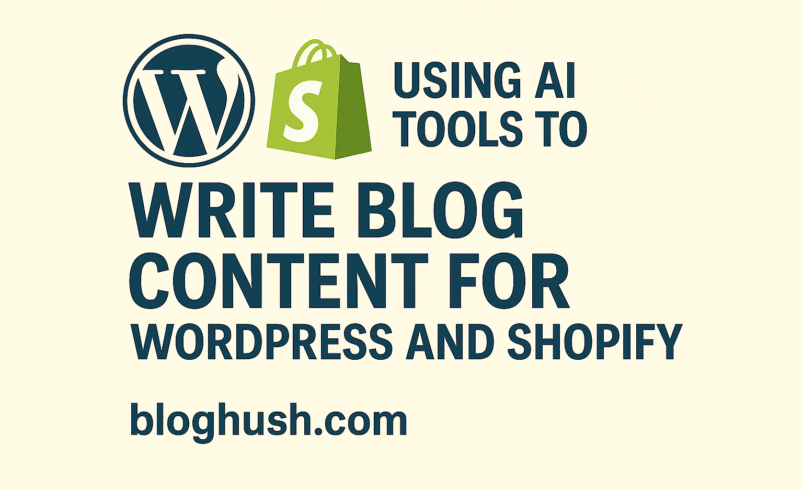Blogging is a powerful way to drive traffic to your WordPress or Shopify site, but creating consistent, high-quality content can be time-consuming. Artificial Intelligence (AI) tools can help you write blog posts faster, allowing you to focus on growing your business. At BlogHush.com, I’m here to guide you through using AI tools to create blog content with a clear, beginner-friendly approach. With 15 years of experience in WordPress, Shopify, and SEO, I’ve seen how AI can simplify content creation for small business owners and bloggers. In this guide, we’ll explore how to use AI tools to write blog content for WordPress and Shopify in 2025, while ensuring it supports your SEO goals. Let’s get started!
Why Use AI Tools for Blog Content?
AI tools use natural language processing to generate human-like content, saving you hours on writing and brainstorming. In 2025, AI content creation is on the rise, with 62% of bloggers using AI tools to draft posts (Google Trends, 2025). For WordPress and Shopify users, blogging drives organic traffic—Shopify reports that 67% of its 1.75 million merchants’ transactions come from mobile users (Shopify Blog, 2025), and WordPress powers 43.2% of websites (W3Techs, 2025), with 54% of web traffic being mobile (StatCounter, 2025). AI-generated content can help you publish more frequently, target keywords, and improve SEO, as long as it’s high-quality and user-focused (Google Search Central, 2025).
Step-by-Step Guide to Using AI Tools for Blog Content
Step 1: Choose the Right AI Tool
- Jasper (Free trial, plans start at $29/month, 2025): Known for generating blog posts, product descriptions, and social media content.
- Writesonic (Free plan up to 10,000 words/month, 2025): Offers templates for blog ideas, intros, and full articles, with SEO optimization features.
- Select a tool based on your needs—Jasper is great for long-form content, while Writesonic excels at quick drafts. Both support WordPress and Shopify content creation.
Step 2: Generate Blog Post Ideas
- Log into your chosen AI tool (e.g., Jasper or Writesonic).
- Use the “Blog Post Ideas” or “Content Ideas” feature—input your niche (e.g., “eco-friendly candles” for Shopify or “SEO tips” for WordPress).
- Example prompts:
- “Generate 5 blog post ideas for a Shopify store selling eco-friendly candles.”
- “Suggest 3 blog topics for a WordPress blog about SEO for beginners.”
- Review the suggestions (e.g., “Top 5 Eco-Friendly Candle Trends for 2025”) and pick one to develop further.
Step 3: Write a Blog Post with AI
- Select the “Blog Post” template in your AI tool.
- Input details like the title (e.g., “Top 5 Eco-Friendly Candle Trends for 2025”), target audience (e.g., eco-conscious shoppers), and keywords (e.g., “eco-friendly candles 2025”).
- Let the AI generate a draft—most tools create an intro, headings, and body content in minutes.
- Edit the draft to add your unique voice, ensuring it aligns with Google’s E-E-A-T guidelines (Experience, Expertise, Authoritativeness, Trustworthiness) for 2025 (Google Search Central, 2025).
Step 4: Optimize Content for SEO
- Add keywords naturally throughout the post (e.g., “eco-friendly candles” in the title, intro, and subheadings).
- Include alt text for images (e.g., “eco-friendly candle on wooden table”) to improve accessibility and SEO.
- For Shopify, use the “Search engine listing preview” in the blog editor to add a meta description (e.g., “Discover the top 5 eco-friendly candle trends for 2025 to shop sustainably!”).
- For WordPress, use Rank Math (version 1.0.215, 2025) to add a meta description and optimize for focus keywords.
Step 5: Publish the Blog Post
- For Shopify: Go to Online Store > Blog Posts > Add Blog Post, paste the content, add images, and publish.
- For WordPress: Go to Posts > Add New, paste the content, add images, and publish using the block editor.
- Ensure the post is mobile-friendly—67% of Shopify users and 54% of global web traffic are mobile (Shopify Blog, StatCounter, 2025). Test with Google’s Mobile-Friendly Test tool.
Step 6: Promote Your Blog Post
- Share the post on social media platforms like Instagram or Pinterest to drive traffic.
- Add a link to your Shopify store’s homepage or a relevant product page (e.g., a candle collection).
- For WordPress, use a plugin like Social Snap (free plan, 2025) to add social sharing buttons to your post.
- Monitor performance in Google Analytics to see how the post drives traffic and engagement.
Tips for Using AI Tools Effectively
- Edit for Quality: AI content can sometimes lack personality—always edit to add your unique voice and ensure accuracy.
- Avoid Over-Reliance: Use AI as a starting point, not a final product, to meet Google’s quality guidelines (Google Search Central, 2025).
- Target Long-Tail Keywords: Focus on specific keywords (e.g., “eco-friendly candle trends 2025”) to attract targeted traffic.
What’s Next?
You’ve created your first AI-generated blog post for WordPress or Shopify—great job! Next, explore more AI tools with our Using AI Chatbots for Shopify Customer Support or enhance your blog’s SEO with our WordPress SEO Guide. Stay tuned to BlogHush.com for more tech tips!

Leave a Reply